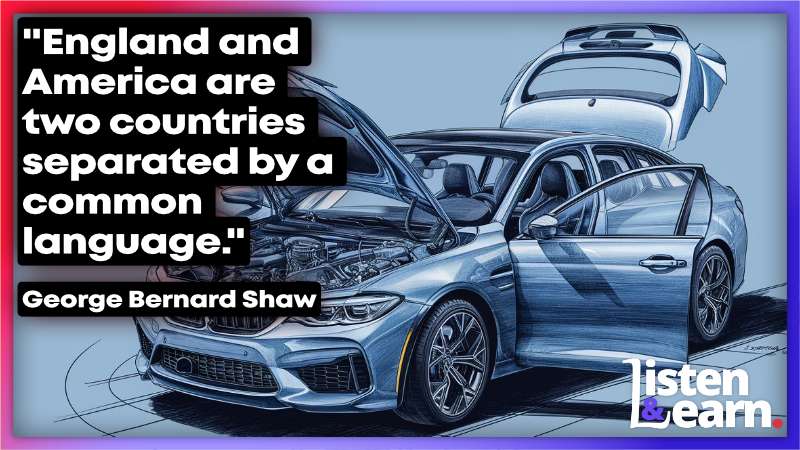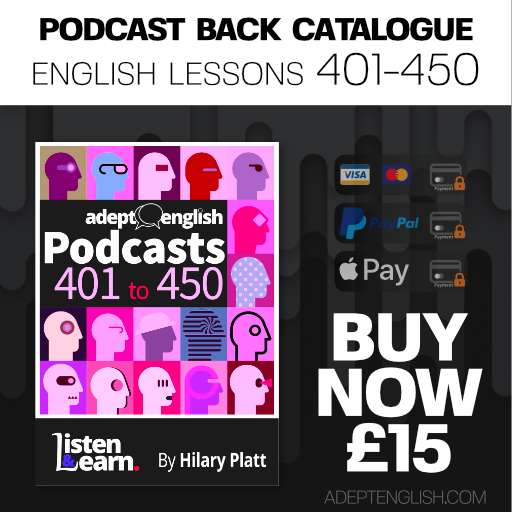English Phrases: Sound More Fluent When Talking About Cars
Discover 6 reasons why American English bothers British viewers. We'll explain American and British car terms in this English lesson! Perfect for anyone who watches English Movies & TV (Pretty sure that's everyone!). Click play and have fun!
- Learn essential car vocabulary 🛠️
- Compare British vs. American English 🏆
- Improve fluency and British pronunciation 🔥
✔️ Lesson transcript: https://adeptenglish.com/lessons/english-phrases-british-vs-american-car-vocabulary/
Want to improve your English comprehension? Head to Adept English and view our video to find out how our method can boost your listening skills.
“England and America are two countries separated by a common language.”
▪️ George Bernard Shaw
This lesson helps you learn many new words. You'll find out how British and American people talk differently about cars and driving. You'll learn new words and how to use them in real life.
This will help you understand English better and talk to more people. You'll be able to speak well with people from different English-speaking countries. Learning these words will make your English better and more useful in many places.
Follow and subscribe to our FREE English language podcast, wherever you listen or watch your podcasts.
More About This Lesson
Discover the fascinating differences between British and American English when talking about cars! From "boot" to "trunk" and "windscreen" to "windshield," this lesson explores how these two versions of English describe various car parts and concepts differently.
“Language is the road map of a culture. It tells you where its people come from and where they are going.”
▪️ Rita Mae Brown
This lesson is great for people learning English:
- Understand key differences between British and American car vocabulary. 🚗
- Improve your listening skills with real-world English usage. 👂
- Expand your vocabulary for everyday conversations about cars and driving. 📚
- Practice pronunciation of terms like ‘bonnet’ vs. ‘hood’. 🗣️
- Learn useful idioms and phrases related to driving and vehicles. 🚙
- Get insights into spelling differences like ‘licence’ vs. ‘license’. ✍️
It teaches you words you can use every day when talking about cars. This is very helpful. When you know how British and American people say things differently, you become better at speaking English. Learning these differences can be fun too! It makes your English more interesting. Also, it helps you talk better with people from Britain or America. You can change how you speak to match the person you're talking to. This makes you a really good English speaker!
- If you feel we have helped you please consider supporting us https://adeptengli.sh/donate
This lesson teaches you important things. First, you'll learn that car parts have different names in British and American English. This is handy to know, especially for movies and TV!
“One language sets you in a corridor for life. Two languages open every door along the way.”
▪️ Frank Smith
Second, when you understand these differences, you won't get mixed up when talking to people. Third, learning both ways of saying things makes your English better overall. Last, we use real-life examples to help you remember. This makes learning fun and easy.
Ready to drive your English skills forward? Tune in to our podcast now and discover more fascinating lessons on British and American English differences. Subscribe to Adept English for hundreds of valuable English lessons that will boost your fluency on the go!
Frequently Asked Questions (FAQ)
- What are some key differences between British and American car vocabulary? British and American English have several car vocabulary differences. In the UK, the storage area at the back is a "boot," while in the US, it's a "trunk." The front covering over the engine is a "bonnet" in the UK and a "hood" in the US. The glass at the front is a "windscreen" in Britain and a "windshield" in America. Fuel is "petrol" in the UK and "gas" in the US. Lastly, Brits say "manual transmission," whereas Americans say "stick shift." Learning these terms helps in conversations about cars in both contexts.
- How can learning car vocabulary help improve my overall English fluency? Learning car words can help you speak English better. It lets you join in on car talks and know more words. Using these words makes you clearer and shows you know regional differences. As you get used to these terms, you'll feel more confident in English. True fluency comes from knowing words from different topics. Car vocabulary is just one part of learning English well.
- Are there spelling differences between British and American English for car-related words? British and American English have different spellings for car words. For example, the rubber ring around a wheel is "tyre" in the UK and "tire" in the US. The document that lets you drive is "licence" in Britain and "license" in America. These differences are part of a bigger set of spelling changes between the two versions of English. Learning these helps you understand car words better and improves your writing in both types of English.
- How can I practice using British and American car vocabulary effectively? To practice British and American car words, use real stuff from both places. Listen to car podcasts or watch car videos from the UK and the US to hear both accents. Read car magazines or websites from both countries to see how they write about cars. Pretend to talk about cars in different situations to use the words. Use language apps to chat with native speakers about cars. Doing these things often will help you learn the car words and use them easily in conversations.
- Why is it important to understand both British and American car vocabulary? Knowing British and American car words is important for several reasons. First, it helps you talk to people from different places. Second, it gets you ready for travel, school, or work in English-speaking countries. It also shows you understand and respect different cultures. This knowledge is useful in business and travel, helping you avoid mistakes in conversations. By learning both versions, you'll be ready to talk confidently no matter which type of English you hear.
Most Unusual Words:
- licence: A document showing you are allowed to drive (UK spelling of "license").
- tyre: The rubber part of a car wheel that touches the road (UK spelling of "tire").
- bonnet: The hinged cover over a car's engine (UK term; "hood" in US).
- windscreen: The front window of a car that protects you from the wind (UK term; "windshield" in US).
- petrol: A liquid used as fuel for cars (UK term; "gas" in US).
- accelerator: The pedal in a car that makes it go faster (UK term; "gas pedal" in US).
- brake: The pedal used to slow down or stop a car.
- clutch: The pedal used to change gears in a manual car.
- manual transmission: A type of car where you change gears by hand (UK term; "stick shift" in US).
- stick shift: A type of car with a manual transmission, where you use a gear lever (US term).
Most Frequently Used Words:
| Word | Count |
|---|---|
| English | 29 |
| American | 9 |
| Might | 7 |
| British | 6 |
| About | 6 |
| Would | 6 |
Listen To The Audio Lesson Now
Transcript: 6 Reasons Why American English Bothers British Viewers
Compare British and American Car Related Vocabulary!
Hi there. At Adept English we focus on British English. But don't you think it's fun and interesting to explore the differences between British English and American English? And there's no subject where there seem to be more differences than in cars and driving. Let's look today at the different words we use in English for the parts of a car, or words that you might encounter when driving. So stay with me and you'll discover interesting differences between British, UK English and American or US English.
Do you want to access more podcasts?
Before I do any of that, just a quick reminder. If you enjoy the Adept English podcast, have you thought about accessing more? You can find hundreds more podcasts by visiting our website and purchasing one of our podcast bundles.
Boost Your Learning With Adept English
These are bundles of 50 podcasts, which you can download all at once for a small fee. It's really good value for money, great English listening practice to have on your mobile phone. And when you listen to 50 podcasts, you notice that your English is improving. Go to our website at adeptenglish.com and our Courses page to find out more.
Hello, I’m Hilary, and you’re listening to Adept English. We will help you to speak English fluently. All you have to do is listen. So start listening now and find out how it works.
Do you find American spelling simpler than British spelling?
So have you noticed that some differences between British and American English are just in the spelling? American spelling is often more simplified. For example, in UK English, the word 'night', as in 'night and day', we spell it N-I-G-H-T, whereas in America, they would spell it N-I-T-E. So it's not surprising that certain words associated with cars and driving are also spelled differently. An example of this would be the spelling of 'driving licence'. That's the permit, usually a document, or in the UK, it's a plastic card that shows that you've passed your driving test and you're qualified to drive. What does it look like? My one looks like that. It's a UK driving licence. In the UK, it's spelled L-I-C-E-N-C-E, whereas in the US, it's spelled L-I-C-E-N-S-E. And that's in line with words like 'practice'. I say 'practice' a lot in Adept English podcasts. It's the noun that has the C and the verb that has the S in UK English. In American English, both have the S. So that's 'driving licence'.
📷
A technical drawing schematic of a car. Improve your listening by hearing real examples of car vocabulary.
And if you're talking about the car wheels, we might speak about 'tyres'. Those are the rubber rings round the wheels that are in contact with the road. It's the same word in UK and US English. It's just in British English, it's T-Y-R-E, and in American English, it's T-I-R-E.
Bonnet and Hood, Boot and Trunk!
And there are some parts of a car that you're probably familiar with the differences in vocabulary. I'm sure there are more than these. But the common ones are these. If you think about the space at the back of a car where you put your luggage or your shopping bags, then British English, we would call that the 'boot'. B-O-O-T. In American English, that's the 'trunk'. T-R-U-N-K. Like the 'trunk' of an elephant. So the 'boot' or the 'trunk'.
And assuming your car's engine is situated like most at the front of the car, then the lid above it, which you lift up to get to the engine, for us, in the UK, that's the 'bonnet'. B-O-N-N-E-T. That's a lovely word. It's also the word for a very old-fashioned hat that women and girls used to wear, 'a bonnet'. But in American English, this is the 'hood'. H-O-O-D. A bit like the word for 'neighbourhood', actually, in US English. So you might 'pop the bonnet' or 'pop the hood', depending upon which side of the Atlantic you are.
Gas and windshield or Petrol and windscreen?
And what about the glass at the front of the car? The glass that sometimes gets shattered or damaged when stones fly up when you're driving. Well, in UK English, this is the 'windscreen'. W-I-N-D-S-C-R-E-E-N. The word 'screen' is used in lots of contexts, but 'screen' often means a flat piece of glass, which covers the display on our TV, our mobile phone, or our computer. That's a 'screen'. And so the windscreen of our car protects us from the wind as we drive along. In US English, this is the 'windshield'. That's W-I-N-D-S-H-I-E-L-D. Absolutely the same meaning, but 'a 'shield'. That's the word for a protective large flat object, something that soldiers might have held in battle to protect themselves. That's a 'shield'. So that's 'windscreen' and 'windshield'.
And when it comes to the fuel that you might put into the car, assuming that it's a petrol engine car anyway, there you have it. In the UK we say 'petrol', short for 'petroleum'. But in the US it's called 'gas', G-A-S, short for 'gasoline'. And similarly we would say the 'petrol station'. That's the place where you go to fill up your car with petrol. Whereas Americans would call this the 'gas station'.
And again, back to parts of a car. The 'accelerator pedal', P-E-D-A-L, that's the lever that you press with your foot to make the car go faster. So I said it - for us that's the 'accelerator'. Whereas for Americans, it's the 'gas pedal'. The other two are called the 'brake', B-R-A-K-E. That's what you slow the car down with. And the 'clutch', C-L-U-T-C-H. And of course you might drive a diesel engine car. That's easy. 'Diesel', D-I-E-S-E-L, that's the same in both British English and American English.
The US and UK in different gears!
One piece of vocabulary which is different in the US and the UK reflects the popularity of different types of vehicle. With reference to how we change gear. Cars have 'gears', G-E-A-R. Usually first 'gear' is used for the slowest speed. And at the other end, cars commonly have a fifth or sixth 'gear'. That's for if you want to go at speed. There's also a reverse 'gear' for if you want to go backwards. Useful when you're parking. In the UK, far more people own a car with a gear stick. So that you actively use your clutch and your gear stick to change gear when you're driving.
British English Vocabulary For Vehicles | From Taxis To Lorries
And of course you use that clutch pedal to disengage whilst you change gear. And that's most of the cars in Europe. They have gear sticks. So cars with a gear stick are called 'manual' or 'manual transmission'. The word 'manual', M-A-N-U-A-L, means 'by hand'. So here you're changing gear by hand. It's a manual car. So that's the norm in the UK and most of Europe. I like a geared car. I have driven automatics, but I much prefer a car with a manual gearbox. The opposite is an 'automatic transmission' car or 'automatic'. And it's called that both sides of the Atlantic, both in the US and the UK. So the car automatically changes gear for you.
A word to practise pronouncing - ‘stickshift’!
So in the UK, the default is the 'manual transmission' car. In the US, however, automatic cars are the norm. The vast majority of cars are 'automatic transmission' and a manual gearbox is unusual. The word they use for a manual gearbox, it's a 'stick shift'. S-T-I-C-K S-H-I-F-T, 'stick shift'.
Download The Podcast Audio & Transcript
Solve The Maths Problem To Download Audio & Transcript
That's one to practise saying. We don't use that word here, although most Brits would know what that meant, a 'stick shift'. So in the US, 'stick shift' cars are more unusual. And when it comes to your driving licence, you might be qualified to drive either type of car or only qualified to drive an automatic. So Americans driving in the UK need to be careful to rent an automatic vehicle, not a stick shift.
Goodbye
That's as well as remembering to drive on the left-hand side of the road. Pretty important to remember that one! Anyway, I hope that gives you some new and interesting vocabulary around cars and driving and an awareness of the words that are different in US and UK English.
Enough for now. Have a lovely day. Speak to you again soon. Goodbye
Thank you so much for listening. Please help me tell others about this podcast by reviewing or rating it. And, please share it on social media. You can find more listening lessons and a free English course at adeptenglish.com
Links
- Manual transmission
- How to drive with a stick shift
- If you feel we have helped you please consider supporting us https://adeptengli.sh/donate
- More great phrases lessons
- Find us on Spotify
- Read along on YouTube
- Apple Podcasts
- Find our 🎧 podcast on other platforms here 👈
- English language courses
- Listen & Learn
- Podcast Bundles
- Downloads
















